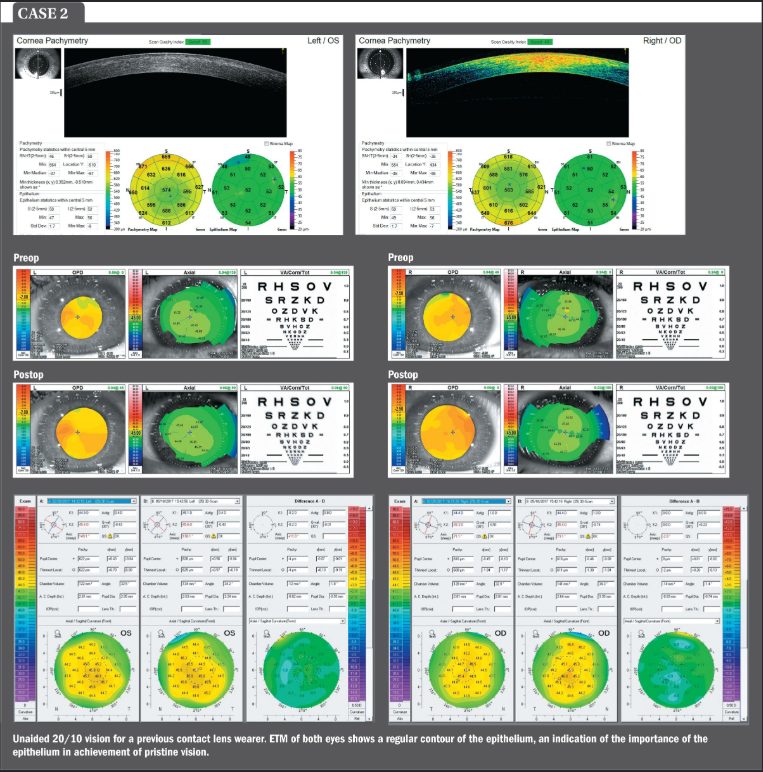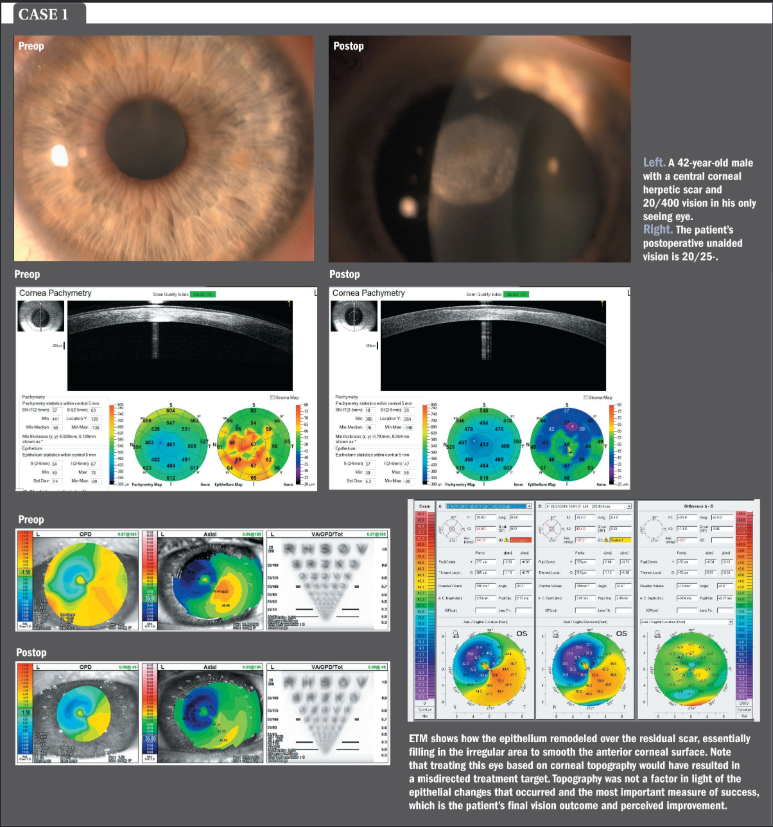Article
ETM valuable in planning, evaluation of outcomes
Author(s):
Quantitative measurement indicates corneal epithelium plays crucial role in outcomes




Arun C. Gulani, MD, MS, and Aaisha A. Gulani, BS, share how epithelial-based refractive surgery can allow surgeons to achieve unprecedented vision results with the least invasive procedures in even the most complex cases.
For many years, I have been traveling the world teaching surgeons about Corneoplastique-my philosophy and practice whereby any eye with visual potential can attain 20/20 or better unaided vision with individualized use of the entire range of ocular surface, corneal, and intraocular techniques.1
This approach focuses on the refractive endpoint of unaided emmetropia and considers the spectrum of available techniques in a holistic way to prepare and repair the eye. As a result, virgin eyes with refractive error can achieve vision beyond 20/20, and nearly any post-surgical problem can be repaired to 20/20.
In addition, noncandidates -for reasons including corneal scar, thin cornea, ectasia, and irregular astigmatism-can be converted to candidates for pursuing excellent vision results.
Adding epithelial thickness mapping
A recent addition to this approach is epithelial thickness mapping (ETM). ETM-an anterior segment optical coherence tomography (AS-OCT) mode available with certain OCT technology (iVue, iFusion, and Avanti, all from Optovue)- is the only FDA-approved, non-contact method of quantitatively measuring the corneal epithelium and stroma.
With a large 9-mm scan, it maps epithelial patterns and irregularities that are associated with subclinical keratoconus and ectasia risk,2 dry eye disease,3 and previous refractive surgery.4,5
As such, ETM is a valuable tool for presurgery risk evaluation, surgical planning, evaluation of outcomes, and enhancement procedure planning. I have long suspected that the epithelium plays a significant role in quality of vision and refractive surgery outcomes.
ETM enables me to document this.6 To further elucidate the role of the epithelium, I am mapping epithelial thickness before and after the Corneoplastique procedures. ETM repeatedly indicates a strong correlation between vision and the smoothness of the epithelium.
The epithelium appears to smooth the anterior cornea and maximize the interplay of the eye’s optical components despite underlying irregular stroma. I believe this helps to explain the successful results I’ve achieved over three decades using the least-invasive procedures to provide patients with life-changing quality of vision.7 Consider, for example, the following case examples.
Case 1Unaided 20/25 vision for eye with central corneal herpetic scar in only seeing eye
Based on multiple consultations with other surgeons, a 42-year-old male patient with a central corneal herpetic scar and 20/400 vision in his only seeing eye expected to require a corneal transplant to obtain usable vision.
Instead, given that his vision in that eye was correctable to 20/50, after a detailed informed consent, he elected to proceed with laser Corneoplastique (epithelium removal and modified excimer laser application) to refractively reshape the scar without treating the underlying cornea. Despite the presence of residual scar, and no improvement in astigmatism, the patient’s postoperative unaided vision is 20/25-. ETM shows how the epithelium remodeled over the residual scar, essentially filling in the irregular area to smooth the anterior corneal surface.
Note that treating this eye based on corneal topography would have resulted in a misdirected treatment target. Topography was not a factor in light of the epithelial changes that occurred and the most important measure of success, which is the patient’s final vision outcome and perceived improvement.
Case 2Unaided 20/10 vision for a previous contact lens wearer
Based on a thin cornea, high-myopic astigmatism, and predisposition for dry eye, I recommended advanced surface ablation for this 34-year-old female who desired freedom from contact lenses. Her postoperative unaided visual acuity is 20/10. She reports 10/10 satisfaction with the improvement, especially with night vision, which, she notes is much better than her previous night vision with contact lenses. ETM of both eyes shows a regular contour of the epithelium, an indication of the importance of the epithelium in achievement of pristine vision.
Case 3Unaided 20/30 vision for eye with posterior corneal scars
Forceps trauma suffered at birth caused a posterior Descemet’s tear and posterior corneal scars in the right eye of this 23-year-old male. His cornea was ectatic, he had 5.2 D of irregular astigmatism and visual acuity of 20/400, which was correctable to 20/50. Rather than perform a lamellar transplant to stabilize the cornea and improve its shape, I placed corneal inserts (Intacs, Addition Technology) with careful selection of incision axis. The result was a nearly 4 D reduction in astigmatism (arrows) and unaided 20/30 vision.
ETM shows a higher anterior regularity, apparently a compensatory mechanism for overriding the posterior corneal irregularity, which is the likely explanation for the patient’s subjective and objective vision improvement and extreme satisfaction.
Case 4Unaided 20/20 vision with laser following failed intacs
A 47-year-old female was referred to me after Intacs placed by her surgeon to address keratoconus in the right eye extruded into the anterior chamber. The surgeon extracted the corneal inserts, which caused a scar. The previous surgeon had also performed corneal crosslinking, which stabilized the cornea and allowed me to reshape it with laser Corneoplastique (the eye was refractable to 20/25) without disturbing the previous surgery.
The outcome of the laser procedure is unaided 20/20 vision despite lack of change in astigmatism on topography. Postoperative ETM shows the epithelium remodeling to fill in not only the refractively induced corneal curvature but also the area of the scar and the uneven stromal thickness that is the hallmark of the keratoconus itself.
Seeing the whole picture
Now is a good time for refractive surgeons to begin using ETM to understand the role of the epithelium in each case. Developing an understanding of the different patterns and changes in the epithelium and how they impact patients’ vision will move the field toward better outcomes, much like what occurred with the emergence of topography many years ago.
With my work involving Corneoplastique and ETM, I aim to confirm that epithelial-based refractive surgery can allow surgeons to achieve unprecedented vision results with the least-invasive procedures in even the most complex cases.
Looking beyond corneal shape to another dominant impact factor in keratorefractive surgery, my practice is continuing to collect images and data from cases across the spectrum of refractive procedures and complications referred to us in order to potentially prepare a next-generation atlas. The epithelium-seen in the past as the mole hill in the realm of vision correction-may be the mountain.
Disclosures:

Arun C. Gulani, MD, MS
E: gulanivision@aol.com
Dr. Gulani, an anterior segment specialist and creator of the Corneoplastique concept of vision correction, is the founder of Gulani Vision Institute in Jacksonville, FL.

Aaisha A. Gulani, BSMs. Gulani is a senior at the University of Pennsylvania where she’s concentrating on healthcare management and finance at the Wharton School of Business.
References:
1. Gulani AC. Corneoplastique: Art of vision surgery. Indian J Ophthalmol. 2014; 62:3-11.
2. Li Y, Chamberlain W, Tan O, Brass R, Weiss JL, Huang D. Subclinical keratoconus detection by pattern analysis of corneal and epithelial thickness maps with optical coherence tomography. J Cataract Refract Surg. 2016;42:284-295.
3. Kanellopoulos AJ, Asimellis G. In vivo 3-dimensional corneal epithelial thickness mapping as an indicator of dry eye: preliminary clinical assessment. Amer J Ophthalmol. 2014;157:63-68.
4. Kanellopoulos AJ, Georgiadou S, Asimellis G. Objective evaluation of planned versus achieved stromal thickness reduction in myopic femtosecond laserassisted LASIK. J Refract Surg. 2015;31:628-632.
5. Tang M, Li Y, Huang D. Corneal epithelial remodeling after LASIK measured by Fourier-domain optical coherence tomography. J Ophthalmol. 2015;2015:860313.
6. Gulani AC. Irregular astigmatism to 20/20. Presentation at the International Refractive Surgery Congress, Shanghai, China, May 2018.
7. Gulani AC. Corneal re-shaping for irregular astigmatism: back to 20/20. Presentation at the Advanced Refractive Congress, Ft Lauderdale, FL, July 2018.
Newsletter
Don’t miss out—get Ophthalmology Times updates on the latest clinical advancements and expert interviews, straight to your inbox.





